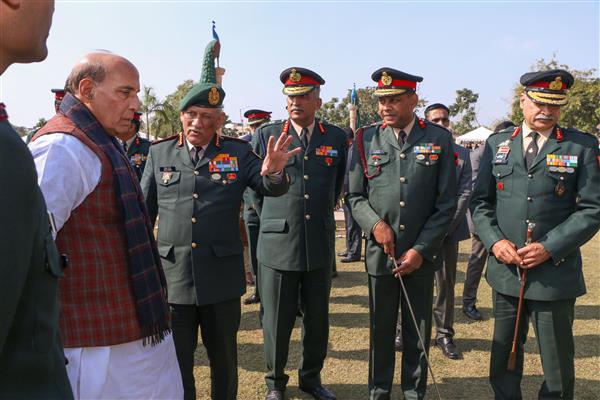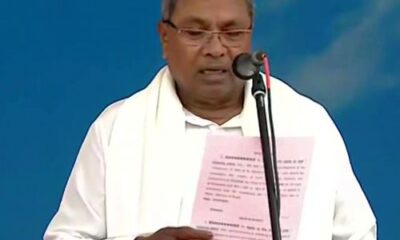National
25th year of Kargil Vijay Diwas: 'Operation Safed Sagar' proved 'Airpower is decisive and non-escalatory'
New Delhi, July 25: The Indian Air Force (IAF)’s exceptional professionalism was on full display, deploying aerospace power at the highest known height in the world for the operations named ‘Operation Safed Sagar’. The IAF aircraft operated at altitudes over 20,000 feet, a feat not attempted before by any Air Force of the World, successfully surmounting the difficulties posed by extreme elevation and inclement weather conditions.
The rapid technological innovations and modifications proved to be highly advantageous to emerge victorious in this conflict, which took place at the highest battleground in the globe.
The Beginning
Pakistan code name for Kargil War was ‘Operation Koh-e-Paima’, which was approved on January 16, 1999, by the Pakistani COAS Op Koh Paima, less than five weeks before the two prime ministers signed the momentous Lahore Declaration on February 22, 1999.
The Pakistani Army initiated the occupation of territory in the Kargil region shortly afterwards.
On May 3, 1999, the Indian Army discovered that the Pakistanis were present on Indian territory. The infiltration and combat occurred in ridges that overlook the road connecting Srinagar and Leh.
The military outposts situated on the elevated areas above the roadway typically had altitudes of around 5,000m (16,000 ft), with a few risings as high as 5,485m (18,000 ft).
The Indian Air Force (IAF) received its initial request for air support on May 11, 1999, specifically for the helicopters.
Subsequently, on May 25, the Cabinet Committee on Security (CCS) granted permission to the IAF to launch offensive operations against the infiltrators while ensuring they do not breach the Line of Control (LoC).
Air Operations
Kargil war was a conflict that underscored the need for a robust and responsive defence strategy. Chief of Defence Staff General Anil Chauhan, in an event in New Delhi on July 18, 2024 to mark 25 years of Kargil Vijay Diwas, said: “The Kargil conflict highlighted the significance of maintaining vigilance and preparedness for safeguarding our borders. It also emphasised the importance of public and international diplomacy, a strategy which was used effectively to maintain the neutrality of inimical nations and gain global support.”
The Indian Air Force’s operations during the Kargil conflict are a prime illustration of operational preparation, intelligence collection, and diplomatic initiatives while encountering numerous impediments.
Intelligence, Surveillance, and Reconnaissance (ISR) capabilities were limited, affecting target identification and battle damage assessment. The reconnaissance mission by IAF’s Canberra aircraft played a crucial role in the Kargil conflict, detecting the level and limits of Pakistani intrusions and providing vital intelligence.
This early detection was instrumental in the IAF’s subsequent operations. The IAF’s fighter jets, including MiG-21s, MiG-27s, and Jaguars, then provided close air support to ground troops and attacked enemy positions.
The Mirage-2000 aircraft carried out precision strikes using laser-guided bombs, targeting enemy bunkers and supply depots.
Total of 7,631 sorties were flown — then the IAF had 42 fighter sqns in 1999 but only 90 aircraft were deployed, 45 in the valley and 45 out of the valley.
Fighter flew 1,730 sorties (Day ops sorties:1,643 & Night sortie:87), Helicopter: 2,474, Transport ac: 3,427 (Max).
During the conflict, the IAF’s role in transporting over 20,000 troops, 1,500 tonnes of equipment, and 1,200 tonnes of ammunition was a testament to their logistical capabilities and the scale of their operations.
Full Force Braveheart Operations: IAF aircraft conducted night operations using available technology such as night vision goggles and navigation systems, demonstrating their adaptability and commitment to mission success.
IAF transport aircraft and helicopters ferried troops, equipment, spares and other support supplies to forward bases, maintaining a steady supply chain.
IAF helicopters, including Mi-17s and Mi-35s, conducted daring rescue missions, evacuating wounded soldiers from forward areas.
Coordination with Army: The IAF’s close coordination with the Indian Army, providing real-time intelligence and strike support, was a testament to the strength and unity of the Indian defence forces, reassuring the nation of their combined capabilities.
Effective coordination between the IAF and the Indian Army played a vital role in accurately striking enemy locations during the Kargil War.
Decisive Operations: High altitude posed unique operational difficulties in targeting the enemy. Professionally conducted IAF airstrikes disrupted Pakistani troop movement and logistical support, making it difficult for them to reinforce their positions or retreat effectively.
The swift technical modifications and on-the-job training held IAF in good stead in its employment of air power to win this war fought at the highest battlefield of the world.
Overall, IAF flew around 5000 strike missions, 350 reconnaissance/ ELINT missions, and around 800 escort flights. The IAF also flew over 2,000 helicopter sorties towards casualty evacuations and air transport operations.
The successful air strikes on Tiger Hill, MunthoThalo, and Toling changed the direction of the operations towards India.
Limitations Encountered: In the report compiled by the Kargil Review Committee (KRC), the many constraints that were associated with airpower operations during the Kargil War were brought to light.
The following were the limitations that were encountered during Kargil operations.
(a) Weather Conditions: Harsh weather, including dense fog, clouds, and gusty winds, hindered air operations.
(b) High-Altitude Challenges: Operating at extreme heights posed significant challenges for aircraft and crew.
(c) Logistical Challenges: Transporting fuel, ammunition, and spare parts to forward bases was a significant logistical challenge.
(d) Limited ISR and Air Defence Capabilities: IAF’s air defence systems had limited capabilities against Pakistani missiles and aircraft.
It is testament to the exceptional skills of the IAF and, especially, to their resiliency that they were able to successfully overcome such difficult conditions, which inspired everyone who observed their remarkable efforts.
The IAF was able to achieve significant success in the Kargil War by adapting to new circumstances and utilising its strengths.
Lessons Learnt
The Kargil Conflict led to significant changes in the IAF airpower operations, including:
(a) Modernised IAF: The Indian Air Force (IAF) has included advanced fighter aircraft, including the Rafale, Tejas Mk1A, and MI-17 V, to replace its outdated fleet of MiG series jets, thereby modernising its aircraft fleet.
(b) Enhanced Intelligence, Surveillance, and Reconnaissance (ISR) Capabilities: The ISR capabilities have been enhance capabilities to identify targets and assess combat damage.
(c) Network-Centric Operations (NCO) capacity: The establishment of a network-centric warfare capacity has allowed for the improved situational awareness, leading to timely decision-making.
(d) Advanced Training Incentive: All pilots get comprehensive training for both day and night missions. Regular joint exercises are held to strengthen operational readiness and interoperability.
(e) Logistics and Maintenance Upgrades: Requisite enhancements have been implemented in the logistics supply chain to guarantee accessibility in all types of terrain for all support and maintenance infrastructure.
Conclusion
Kargil Vijay Diwas is celebrated every year on July 26 to commemorate India’s victory over Pakistan in the Kargil War of 1999. The IAF’s airpower operations played a crucial role in the Indian military’s victory in the Kargil War.
Without a shadow of a doubt, the efficient utilisation of air power has prevented more losses and significantly shortened the period of time during which our Army has made such significant advancements on the ground.
(Dr. DK Pandey was the Group Captain in IAF. He undertook AD operations in the Western, J&K and NE sectors. He has commanded six Air Defence (C&R) Units. He was Director Air Staff Inspections and retired as Director, Joint Control and Analysis Centre)
–IANS
scor/
National
Defence Ministry: Year 2025 will be year of reforms

On Wednesday, the Defence Ministry announced that 2025 will be designated as the “Year of Reforms,” with a primary focus on establishing integrated theatre commands to enhance collaboration among the three branches of the military.
These reforms are aimed at transforming the armed forces into a technologically advanced, combat-ready force capable of executing multi-domain integrated operations, the ministry stated.
The initiative will emphasize emerging domains such as cyber and space, alongside cutting-edge technologies like artificial intelligence, machine learning, hypersonics, and robotics.
Defence Minister Rajnath Singh described the “Year of Reforms” as a pivotal milestone in the modernization of the armed forces.
“It will set the stage for significant advancements in the nation’s defense capabilities, ensuring the security and sovereignty of India in the face of 21st-century challenges,” he said.
National
A 3.2 magnitude tremor struck Gujarat’s Kutch district on Wednesday morning

A 3.2 magnitude tremor struck Gujarat’s Kutch district on Wednesday morning, according to the Institute of Seismological Research (ISR).
The district administration reported no casualties or property damage following the quake.
The tremor occurred at 10:24 am, with its epicenter located 23 kilometers north-northeast (NNE) of Bhachau, as per the Gandhinagar-based ISR.
Last month, the region experienced four seismic events exceeding a magnitude of 3, including a 3.2 magnitude tremor just three days ago, with its epicenter also near Bhachau.
Earlier tremors in the area included a 3.7 magnitude earthquake on December 23 and a 3.2 magnitude event on December 7, according to ISR reports.
Kutch was also jolted by a 4.0 magnitude earthquake on November 18, 2024. On November 15, a 4.2 magnitude quake hit Patan in north Gujarat, based on ISR data.
Gujarat is considered a high-risk earthquake zone, having experienced nine major earthquakes over the past 200 years, according to the Gujarat State Disaster Management Authority (GSDMA). The 2001 earthquake in Kutch, which occurred on January 26, was the third-largest and second-most destructive in India in the last two centuries, according to the GSDMA.
National
Diljit Dosanjh faces legal action over concert songs

Singer and actor Diljit Dosanjh’s much-anticipated New Year’s Eve concert in Ludhiana faced legal hurdles after a complaint was filed by Punditrao Dharenavar, an assistant professor from Chandigarh.
Following the complaint, the Deputy Director of the Women and Child Department, Government of Punjab, issued a formal notice to Ludhiana’s District Commissioner, urging them to prohibit Dosanjh from performing specific songs during his live show on December 31, 2024.
The notice specifically targets songs accused of promoting alcohol, including Patiala Peg, 5 Tara Theke, and Case (Jeeb Vicho Feem Labbiya), even if the lyrics are slightly modified. The complaint points to previous warnings issued to Dosanjh by various commissions advising against performing these controversial tracks.
Despite these warnings, the singer allegedly continues to perform the songs with minor alterations. Dharenavar raised serious concerns about the influence of such music on young audiences, especially when minors are present at live events.
Adding to the controversy, Dharenavar referenced a 2019 Punjab and Haryana High Court ruling, which directed law enforcement to ensure that songs promoting alcohol, drugs, or violence are not played at public events, including concerts. This ruling underscores the legal basis for the complaint and has further intensified the scrutiny surrounding the event.
National
UP Minister’s convoy overturns, 5 person injured

Five people sustained injuries when a vehicle in the convoy of Uttar Pradesh Minister and Nishad Party chief Sanjay Nishad overturned into a ditch near Januan village in the Khejuri Police Station area of Ballia district late last night.
Sanjay Nishad shared details of the incident, stating that the accident injured five party workers, including four women.
“I was traveling with the convoy to participate in the Constitutional Rights Yatra organized by the party on Tuesday night. Near Januan village in the Khejuri area, one of the vehicles following the convoy lost control while trying to avoid an animal and overturned into a ditch,” Nishad explained.
The injured individuals have been identified as Rakesh Nishad, Ramrati, Usha, Geeta, and Iravati Nishad.
Senior police and administrative officials quickly arrived at the scene following the incident to oversee the situation.
National
Suchir Balaji’s mother alleges Murder


The mother of Suchir Balaji, a 26-year-old former OpenAI researcher found dead after accusing the company of copyright violations, has alleged that her son was “murdered” and called for a Federal Bureau of Investigation (FBI) probe.
Poornima Rao, Suchir’s mother, claimed her son’s death was a “cold-blooded murder” that authorities wrongly ruled as suicide. She further disclosed that a private autopsy report conflicted with the findings of the initial police investigation.
Rao alleged that her son’s apartment had been “ransacked” and cited evidence of a struggle in the bathroom, including bloodstains that suggested he had been assaulted.
“We hired a private investigator and conducted a second autopsy to uncover the truth. The private autopsy does not confirm the cause of death stated by the police. Suchir’s apartment was ransacked, there were signs of a struggle in the bathroom, and it appears he was hit based on blood spots. This is a cold-blooded murder being misclassified as a suicide. Lobbying in San Francisco won’t deter us from seeking justice. We demand an FBI investigation,” Rao wrote on X.
Elon Musk reacted to Rao’s post, commenting, “This doesn’t seem like a suicide.”
Balaji was discovered dead in his San Francisco apartment months after accusing OpenAI of violating copyright laws during the development of ChatGPT, as reported by Fox News. Despite these claims, the San Francisco Police Department found no evidence of foul play and ruled the death a suicide.
On October 24, shortly before his death, Balaji voiced doubts about the “fair use” defense in generative artificial intelligence. “I recently participated in a NYT story about fair use and generative AI, and why I’m skeptical ‘fair use’ would be a plausible defense for a lot of generative AI products,” he wrote on X.
-
Video2 years ago
PM Modi Attacks Congress in Karnataka with “Kerala Story”
-
Politics2 years ago
Siddaramaiah & DK Shivakumar sworn in as Chief Minister & Deputy CM respectively
-
Cricket2 years ago
CSK players rejoice 5th IPL title with their families (Pics)
-
Entertainment2 years ago
Karan Deol weds his longtime Girlfriend Drisha Acharya (Pics)
-
Sports7 years ago
History Of Official FIFA WORLD CUP Match balls
-
India2 years ago
Ashwini Vaishnaw: Railway Board recommends CBI probe in the Odisha railway disaster
-
Entertainment2 years ago
Urvashi Rautela dazzles on Cannes 2023 red carpet (Pics)
-
Entertainment2 years ago
Sunny Leone gets ready for Kennedy premiere in Cannes (Pics)



























